 Chandranath Basak
Chandranath Basak
Bio: I am a paleoclimatologist with special interest in understanding the past deep ocean circulation and weathering patterns during times of dramatic climate change. I use Nd and Pb isotopes in fossil fish teeth/debris and Fe-Mn oxide coatings on marine sediments to address these issues. Recently, I completed my Ph.D. from University of Florida and will be joining as a post doctoral research fellow with the Max Planck marine isotope group in Germany.
On This Cruise: Several proxies showed that intermediate water circulation play an important role during times of dramatic climate change. Relatively few studies have been done for tracking past intermediate water circulations. Nd isotopes in fossil fish teeth are used regularly to study deep ocean circulation. Studies of intermediate water circulation using fossil fish teeth require cores from intermediate water depths and there are very few potential intermediate sites in the Pacific Ocean. An alternative archive is planktonic foraminifera that dwell in deeper thermocline waters; however, there is much debate about how and where these foraminifera acquire Nd. In this cruise I am collecting plankton tows and ambient sea water. Foraminifera from the plankton tows along with water samples from similar water depths as of the plankton tow will be analyzed for Nd isotopic analyses. I am also collecting core top fossil planktonic foraminifera and bottom water samples for Nd isotopic analyses. Results from this study will help better understand the viability of using planktonic forams as a suitable archive to study intermediate water circulation particularly in places where intermediate core is a limiting factor.
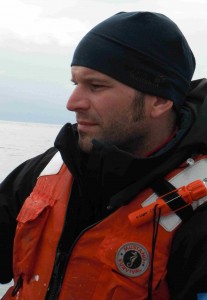 Aaron Beck
Aaron Beck
Bio: I’m a biogeochemist with particular interest in trace metals and radionuclides. I’m currently an assistant professor at the Virginia Institute of Marine Science (College of William & Mary).
On This Cruise: I’m measuring particulate and dissolved trace metals in surface waters. Part of my goal is to size-fractionate the particulates and determine surface-adsorbed and intraparticle metal pools. I hope to determine the relative proportions of lithogenic and biogenic components in the particulate phase; the biogenic metal content should give an indication of trace metal quotas in natural phytoplankton assemblages. Many trace metals are micronutrients necessary for phytoplankton growth, but little is known about metal requirements in natural marine plankton. Results from this cruise (upwelling zone) will be compared with similar work in the North Atlantic Ocean and coastal waters in Virginia and the Chesapeake Bay.
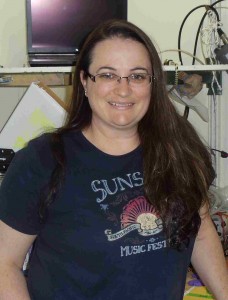 Shellie Bench
Shellie Bench
Bio: I received my undergraduate degree in genetics from UC Davis, and my master’s degree from The University of Delaware where I studied the genetics of viruses in the Chesapeake Bay. I am currently a graduate student in my last year at UC Santa Cruz. My thesis research is focused on genomics of nitrogen fixing cyanobacteria. Specifically I am comparing the genomes of six closely related strains of Crocosphaera, which is a nitrogen fixer that is found globally in tropical oceans. These strains behave differently in culture, but genetic markers have shown them to be identical. So the genome comparisons I am doing are looking for the genetic basis for their differences.
On This Cruise: I am interested in the phytoplankton community that is found within the Columbia River Plume and the community that is found outside of it. While the communities exist in very close proximity to each other, I would expect to see differences between them based on the differences in nutrients that are available in the two type of water. To assess those differences, I am collecting DNA samples (to look at the genetic makeup of the community) as well as samples to run through flow cytometry (to look at
the visual characteristics of the community).
To help make sense of the trends in phytoplankton community, I am measuring various features of the water, including temperature, salinity, oxygen, turbidity, and chlorophyll concentration. I will also be looking for correlations with the nutrient data collected by others on the ship, and my own data for silicate (an important nutrient for the diatoms that are common in this system).
 Sarah Brooks
Sarah Brooks
Bio: The focus of my research is to develop a better understanding of how natural and anthropogenic aerosol particles influence aerosol-cloud interactions. Through a combination of field studies and laboratory experiments, my group explores how the physical and chemical properties of aerosols impact cloud formation and properties. The sea surface microlayer is a potentially large source of surface active organic compounds in marine aerosol. When present in significant quantities in aerosols, surfactants reduce the ambient humidity required for cloud droplets to form, thus extending the range of cloud formation conditions and cloud lifetimes.
On This Cruise: I am collecting samples of size-selected aerosols, sea surface microlayer, and bulk sea water at a one meter depth. In each sample, I will identify organic functional groups (measured by Raman spectroscopy), and the relative ratio of these to the dissolved organic carbon (measured by Dan Thornton) in that sample. Comparison of data collected in the seawater, microlayer and aerosols will be used to determine the partitioning of relevant compounds between the three phases and to provide insight into ocean’s contribution to atmospheric aerosols and cloud formation.
 Russell Carvalho
Russell Carvalho
Bio: I am a graduate student in the last year of my PhD in Oceanography at Texas A&M at Galveston. Having been on a number of oceanographic cruises, I thought it would be really important for me to participate in a Chief Scientist training cruise.
On This Cruise: My studies focus on the community structure of polychaete worms found in the deeper waters (>200m) of the ocean. I am also currently working on generating Ecological Niche Models (ENM) for two families of polychaetes, the Cirratulidae and the Spionidae, which are both considered as surface deposit feeders. The Oregon coast offers a diversity of polychaete species, and obtaining samples from this cruise will help me in obtaining the ideal preliminary data required for future studies in this region.
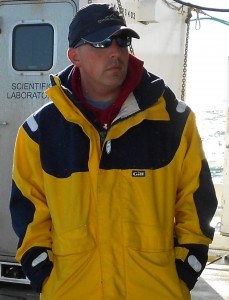 Christopher Hintz
Christopher Hintz
Bio: I am a chemical oceanographer interested in understanding the effects anthropogenic carbon dioxide (CO2) has on the ocean. I am an Assistant Professor at Savannah State University developing a new Aquarium Science Program. In addition, I teach undergraduate and graduate oceanography, and upper-level marine chemistry.
On This Cruise: I am developing improved methods to analyze carbonate chemistry used in understanding ocean acidification. Traditional pH and alkalinity methods use relatively large water volume samples (~20-100 mL) and require specialized (often custom made) analysis equipment (e.g., temperature-controlled titration cells for precise alkalinity measurements). The methods I am developing utlize smaller volumes (1-2 mL) in a commercially-available standard 1-cm path length, but still temperature-controlled, spectrophotometer. This approach has the advantage of adding to the number of laboratories able to conduct high-precision carbonate chemistry and broadening the effort to understand ocean acidification, including its effects on biology or geology. During the W1106A cruise on board the R/V Wecoma I will be sampling the dynamic, but well-studied, Oregon Shelf/Slope water for carbonate chemistry to validate these methods developed in the laboratory and tested within the less-studied estuarine and near shore waters along the Georgia Bight.
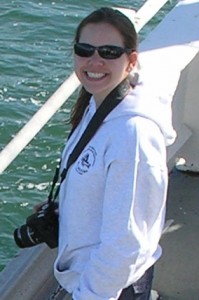 Lindsey Koren
Lindsey Koren
Bio: I am a third year PhD candidate in the Integrative Life Sciences program at Virginia Commonwealth University in Richmond, Virginia. For my dissertation, my research is primarily focused on carbon cycling of Lake Superior.
On This Cruise: I will be investigating different aspects of the carbon cycle in the Pacific Ocean. Throughout the cruise, I will be making in-situ measurements of the partial pressure of carbon dioxide (pCO2) in both the surface water and atmosphere along the cruise track. At specific stations along the transects, I will be conducting both short-term incubations via biological oxygen demand (BOD) and long-term incubations through dissolved organic carbon (DOC) lability experiments. In addition, I will be collecting water samples to measure the source and age of the carbon respired by the bacterial community through stable isotopes and radiocarbon, respectively. With the coupling of these measurements, there can be a better understanding of the carbon cycle of the Pacific Ocean.
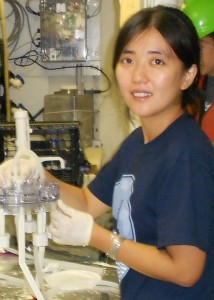 Yuehan Lu
Yuehan Lu
Bio: I am an organic geochemist interested in understanding biogeochemical cycling of organic matter in modern and paleo-ecosystems. I currently work at the University of Alabama as an assistant professor. Several examples of my research projects are: understanding the effects of land uses on organic matter in streams, reconstructing carbon and nitrogen cycles over the development and recovery of cultural eutrophication in Lake Erie, deciphering sources of marine landslide deposits in the Nankai Trough.
On This Cruise: I am collecting dissolved and particulate organic matter samples from the Columbia River Plume transect and the Southern Plume Transect. Colored dissolved organic matter (CDOM) and lipid biomarkers will be characterized in the lab to understand sources and dynamics of organic matter in transitional zones from river plume to shelf water.
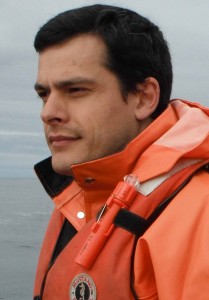 Joaquin Martinez Martinez (Co-Chief Scientist)
Joaquin Martinez Martinez (Co-Chief Scientist)
Bio: I am a marine biologist. My PhD was on the molecular ecology of marine viruses. Currently my research as a postdoc continues to be geared toward investigating how viruses shape the dynamics and ecology of algal blooms, in particular, the role of viruses in bloom termination. I am interested in isolating novel phytoplankton viruses, the interplay between environmental factors and viral infection (e.g., nutrients, dissolved gases), differences between lytic versus lysogenic infection, viruses as a genetic reservoir with great diversity and lateral gene transfer between hosts and viruses. Pseudo-nitzschia is an important phytoplankton species that is difficult to maintain in the laboratory and information on its specific viruses (if any) is limited. Participating in this cruise will offer me an ideal situation for investigating this important diatom in its environment.
On This Cruise: Samples collected in this cruise will be beneficial to my research for the following objectives.
1) Test, in the environment during a natural phytoplankton bloom, a series of microbiological and molecular techniques I have recently developed in the laboratory. These techniques allow targeted metagenomic studies of discrete viral groups. This is an important resource for finding novel genes in the viral community.
2) Isolation of specific viruses to facilitate characterization and sequencing for investigation of novel viral genes.
3) Investigate whether Pseudo-nitzschia undergoes lysogenic infection. This would explain the challenge of specific virus isolation.
4) Study the relationship between viruses and domoic acid production.
In addition to collecting my own samples I have been given the opportunity to be co-chief scientist during the cruise.
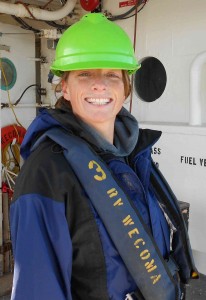 Kimberly Null
Kimberly Null
Bio: Currently I am a postdoctoral researcher at the University of California Santa Cruz. I have a Ph.D. in Marine Science from North Carolina State University.
My research focuses on quantifying submarine groundwater discharge (SGD) and the associated nutrient fluxes to coastal ecosystems, including locations in North Carolina, San Francisco Bay, Monterey Bay, and along the Yucatan Peninsula. My research interests also includes nutrient cycling in estuarine systems, anthropogenic impact on coastal water quality, and biogeochemical processes in sediments.
On This Cruise: I am investigating SGD in nearshore environments and mixing along the Oregon coast. I am collecting large volumes of water to measure radium isotope activities (223,224,226,228Ra) to quantify SGD and to investigate mixing of shelf waters. I think radium is totally rad! Prior to the cruise, I conducted land-based sampling of groundwater and the coastal surf zone. On the R/V Wecoma, I am collecting bottom and surface waters. The large quantity of water is filtered with MnO2 impregnated fibers and will be analyzed on a RaDeCC system back at UCSC. In addition to Ra isotopes, I am measuring nutrients and dissolved organic carbon.
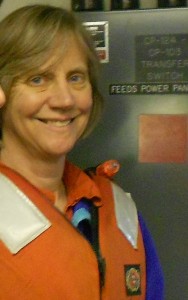 Clare Reimers (Mentor)
Clare Reimers (Mentor)
Bio: Professor, Oregon State University, College of Oceanic and Atmospheric Sciences.
My expertise is in sediment biogeochemistry and chemical oceanography. I have been going to sea for 35 years, and currently I’m the chairperson of the UNOLS Fleet Improvement Committee.
On This Cruise: I organized the Early Career Chief Scientist training program to help new investigators understand how to effectively plan for, acquire, utilize and report on time at sea for multi-disciplinary research and education. I believe expeditionary research at sea is critical to the study of the Ocean as an integrated system, and for achieving scientific understanding of complex environmental phenomena. It’s also rich in opportunities to work with new technology and talented personnel from the crew and science party. On this cruise I am here as a “mentor” but I expect I will also learn to be a more effective chief scientist in the future.
 Alyson Santoro
Alyson Santoro
Bio: I am an Assistant Professor from Horn Point Laboratory (www.umces.edu/hpl) in Maryland. I am a microbial ecologist interested in marine archaea and how they may be involved in the nitrogen cycle.
On This Cruise: I will be looking for a particular group of archaea, the marine Group 2 Euryarchaea. Not much is known about the lifestyle of these archaea, except that they appear to be associated with coastal environments. I will be taking samples across coastal to offshore transects to see how their abundance changes, and to see if they have any associations with different groups of phytoplankton.
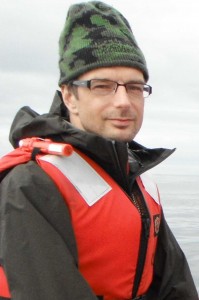 Daniel Thornton
Daniel Thornton
Bio: I am an Associate Professor in the Department of Oceanography at Texas A&M University in College Station. My research interests are microbial ecology and biogeochemistry, particularly the cycling of carbon and nitrogen. I combine a
variety of research approaches from biology and chemistry to address my research questions. I conduct fieldwork (mainly in coastal environments) and controlled experiments in the laboratory (generally with cultured phytoplankton).
On This Cruise: I am collaborating with Sarah Brooks, who is an atmospheric chemist. We are interested in the role of biogenic aerosols in cloud formation. We are going to sample the sea surface microlayer (SML), which is the surface layer of the ocean
at the air-sea interface and is generally considered to be tens of micrometers thick. Both microorganisms and various components of the dissolved organic carbon (DOC) pool get concentrated in the SML and from here they can potentially be lofted into the atmosphere through mechanisms such as bubble bursting. I am going to measure DOC concentrations in the water collected from the SML, as well as from bulk seawater below the SML. In addition, Sarah Brooks will collect samples of aerosol from which I will measure DOC in the water extractable component.
I am also interested in gel particles. These are sticky particles important in aggregate formation and the downward flux of organic carbon in the water column. There are reports that indicate gel particles may be a component of aerosols. I will measure the concentration of transparent exopolymer particles (TEP) and Coomassie staining particles (CSP). TEP are composed largely from acid polysaccahrides and CSP are protein containing gel particles.
 Amy Townsend-Small
Amy Townsend-Small
Bio: I am a biogeochemist with a PhD in Marine Science from the University of Texas at Austin. I am currently an assistant professor in the Departments of Geology and Geography at the University of Cincinnati in Ohio.
On This Cruise: I will be sampling water at all of the stations along the cruise and measuring concentrations of methane and nitrous oxide in the water column. Previous work has shown that upwelling regions can contribute significantly to atmospheric greenhouse gas concentrations.
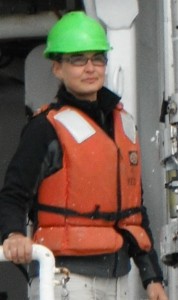 Penny Vlahos (Co-Chief Scientist)
Penny Vlahos (Co-Chief Scientist)
Bio: I am a chemical oceanographer who studies the global cycling of carbon and organic carbon including anthropogenic sources. Specifically, I am interested in the fate and transport of reduced carbon. I have a Masters and Bachelors in Chemical Engineering from the University of Toronto and a doctorate in Chemical Oceanography from the University of Massachusetts.
On This Cruise: The boundary layer between water masses leads to a zone of mixing where chemical gradients are relatively large and are generally known as frontal zones. The Oregon shelf has frontal boundaries leading to both upwelling and downwelling conditions. This study is evaluating both the organic and inorganic pools along the shelf to evaluate shift in carbon pools including dissolved and particulate and their stable isotopic carbon signature to identify important areas where the water dynamics lead to carbon export and/or depletion.
 Pat Wheeler (Mentor)
Pat Wheeler (Mentor)
Bio: Emeritus OSU Distinguished Professor of Oceanic and Atmospheric Sciences. Ph.D. University of California, Irvine. I am a biological oceanographer interested in phytoplankton physiology and ecology especially with respect to carbon and nitrogen cycles in the ocean. My research focused on the production and utilization of dissolved organic carbon and nitrogen in a variety of ocean environments spanning the Arctic Ocean, the Northeast Pacific Ocean, and the equatorial Pacific Ocean. I have had the good fortune of doing much of this research as part of large, interdisciplinary programs with strong physical, chemical, and biological components that facilitate a more complete understanding of physical forcing factors and biological responses. Retirement project: Co-author (with Charlie Miller) of “Biological Oceanography 2nd Ed.”, a textbook for a graduate level course. Publication date is 2012.
On This Cruise: I’ve spent 25+ years going to sea for individual, multi-PI, and multi-ship cruises. Clare enticed me away from other projects to serve as a mentor on this cruise. My shift is noon-midnight and besides mentoring and observing the science operations, I serve as “sample cop” for some of the CTD casts. I’ve really enjoyed my oceanographic career as a scientist, instructor, advisor, author and editor. This group of cruise participants is impressive. I wish them well in their careers and scientific pursuits.
